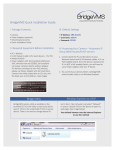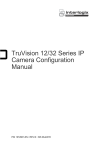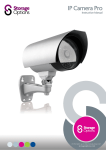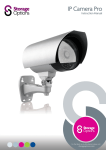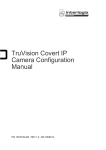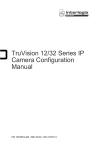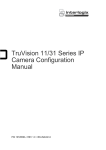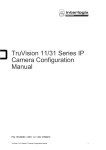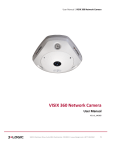Download BridgeVMS 2000 Series Network Camera User Manual
Transcript
2 Mega Pixel “2000” Series Cameras Network Camera User Manual V2.0.1 BridgeVMS 2000 Series IP Camera User Manual This manual is applied to the following camera models: Type Model Dome camera FD2000 Bullet Camera SB2000-IR-OD 1 BridgeVMS 2000 Series IP Camera User Manual 2 Thank you for purchasing our product. If there are any questions, or requests, please do not hesitate to contact BridgeVMS (713) 609-9685. This manual applies to BridgeVMS “2000” Series 2 Mega Pixel Network Camera. This manual is subject to change without notice. Any updates will be added to the new version of this manual. DISCLAIMER STATEMENT “Underwriters Laboratories Inc. (“UL”) has not tested the performance or reliability of the security or signaling aspects of this product. UL has only tested for fire, shock or casualty hazards as outlined in UL’s Standard(s) for Safety, UL60950-1. UL Certification does not cover the performance or reliability of the security or signaling aspects of this product. UL MAKES NO REPRESENTATIONS, WARRANTIES OR CERTIFICATIONS WHATSOEVER REGARDING THE PERFORMANCE OR RELIABILITY OF ANY SECURITY OR SIGNALING RELATED FUNCTIONS OF THIS PRODUCT.” BridgeVMS 2000 Series IP Camera User Manual 3 Regulatory Information FCC Information FCC compliance: This equipment has been tested and found to comply with the limits for a digital device, pursuant to part 15 of the FCC Rules. These limits are designed to provide reasonable protection against harmful interference when the equipment is operated in a commercial environment. This equipment generates, uses, and can radiate radio frequency energy and, if not installed and used in accordance with the instruction manual, may cause harmful interference to radio communications. Operation of this equipment in a residential area is likely to cause harmful interference in which case the user will be required to correct the interference at his/her own expense. FCC Conditions This device complies with part 15 of the FCC Rules. Operation is subject to the following two conditions: 1. This device may not cause harmful interference. 2. This device must accept any interference received, including interference that may cause undesired operation. EU Conformity Statement This product and - if applicable - the supplied accessories too are marked with "CE" and comply therefore with the applicable harmonized European standards listed under the Low Voltage Directive 2006/95/EC, the EMC Directive 2004/108/EC. 2002/96/EC (WEEE directive): Products marked with this symbol cannot be disposed of as unsorted municipal waste in the European Union. For proper recycling, return this product to your local supplier upon the purchase of equivalent new equipment, or dispose of it at designated collection points. For more information see: www.recyclethis.info. 2006/66/EC (battery directive): This product contains a battery that cannot be disposed of as unsorted municipal waste in the European Union. See the product documentation for specific battery information. The battery is marked with this symbol, which may include lettering to indicate cadmium (Cd), lead (Pb), or mercury (Hg). For proper recycling, return the battery to your supplier or to a designated collection point. For more information see: www.recyclethis.info. BridgeVMS 2000 Series IP Camera User Manual 4 Safety Warnings and Cautions Please pay attention to the following warnings and cautions: Hazardous Voltage may be present: Special measures and precautions must be taken when using this device. Some potentials (voltages) on the device may present a hazard to the user. This device should only be used by employees from our company with knowledge and training in working with these types of devices that contain live circuits. Power Supply Hazardous Voltage: AC mains voltages are present within the power supply assembly. This device must be connected to a UL approved, completely enclosed power supply, of the proper rated voltage and current. No user serviceable parts inside the power supply. System Grounding (Earthing): To avoid shock, ensure that all AC wiring is not exposed and that the earth grounding is maintained. Ensure that any equipment to which this device will be attached is also connected to properly wired grounded receptacles and are approved medical devices. Power Connect and Disconnect: The AC power supply cord is the main disconnect device to mains (AC power).The socket outlet shall be installed near the equipment and shall be readily accessible. Installation and Maintenance: Do not connect/disconnect any cables to or perform installation/maintenance on this device during an electrical storm. BridgeVMS 2000 Series IP Camera User Manual 5 Power Cord Requirements: The connector that plugs into the wall outlet must be a grounding-type male plug designed for use in your region. It must have certification marks showing certification by an agency in your region. The connector that plugs into the AC receptacle on the power supply must be an IEC 320, sheet C13, female connector. See the following website for more information http://kropla.com/electric2.htm. Lithium Battery: This device contains a Lithium Battery. There is a risk of explosion if the battery is replaced by an incorrect type. Dispose of used batteries according to the vendor’s instructions and in accordance with local environmental regulations. Perchlorate Material: Special handling may apply. See www.dtsc.ca.gov/hazardouswaste/perchlorate. This notice is required by California Code of Regulations, Title 22, Division 4.5, Chapter 33: Best Management Practices for Perchlorate Materials. This device includes a battery which contains perchlorate material. Taiwan battery recycling: Please recycle batteries. Thermal and Mechanical Injury:Some components such as heat sinks, power regulators, and processors may be hot; care should be taken to avoid contact with these components. Electro Magnetic Interference:This equipment has not been tested for compliance with emissions limits of FCC and similar international regulations. This device is not, and may not be, offered for sale or lease, or sold, or leased until authorization from the United States FCC or its equivalent in other countries has been obtained. Use of this equipment in a residential location is prohibited. This equipment generates, uses and can radiate radio frequency energy which may result in harmful interference to radio communications. If this equipment does cause harmful interference to radio or television reception, which can be BridgeVMS 2000 Series IP Camera User Manual 6 determined by turning the equipment on and off, the user is required to take measures to eliminate the interference or discontinue the use of this equipment. Lead Content: Please recycle this device in a responsible manner. Refer to local environmental regulations for proper recycling; do not dispose of device in unsorted municipal waste. BridgeVMS 2000 Series IP Camera User Manual 7 Safety Instruction These instructions are intended to ensure that the user can use the product correctly to avoid danger or property loss. The precaution measure is divided into ‘Warnings’ and ‘Cautions’: Warnings: Serious injury or death may be caused if any of these warnings are neglected. Cautions: Injury or equipment damage may be caused if any of these cautions are neglected. Warnings Follow these safeguards to Cautions Follow these precautions to prevent serious injury or death. prevent potential injury or material damage. Warnings: Please adopt the power adapter which can meet the safety extra low voltage (SELV) standard. And source with DC 12V or AC 24V (depending on models) according to the IEC60950-1 and Limited Power Source standard. If the product does not work properly, please contact your dealer or the nearest service center. Never attempt to disassemble the camera yourself. (We shall not assume any responsibility for problems caused by unauthorized repair or maintenance.) To reduce the risk of fire or electrical shock, do not expose this product to rain or moisture. This installation should be made by a qualified service person and should conform to all the local codes. Please install blackouts equipment into the power supply circuit for convenient supply interruption. Please make sure that the ceiling can support more than 50(N) Newton gravities if the camera is fixed to the ceiling. If the product does not work properly, please contact your dealer or the nearest service center. Never attempt to disassemble the camera yourself. (We shall not assume any responsibility for problems caused by unauthorized repair or maintenance.) BridgeVMS 2000 Series IP Camera User Manual 8 Cautions: Make sure the power supply voltage is correct before using the camera. Do not drop the camera or subject it to physical shock. Do not touch sensor modules with fingers. If cleaning is necessary, use a clean cloth with a bit of ethanol and wipe it gently. If the camera will not be used for an extended period of time, put on the lens cap to protect the sensor from dirt. Do not aim the camera lens at the strong light such as sun or incandescent lamp. The strong light can cause fatal damage to the camera. The sensor may be burned out by a laser beam, so when any laser equipment is being used, make sure that the surface of the sensor not be exposed to the laser beam. Do not place the camera in extremely hot, cold temperatures (the operating temperature should be between -10°C ~ 60°C), dusty or damp environment, and do not expose it to high electromagnetic radiation. To avoid heat accumulation, good ventilation is required for a proper operating environment. Keep out of water and any liquid. While shipping, the camera should be packed in its original packing. Improper use or replacement of the battery may result in hazard of explosion. Please use the manufacturer recommended battery type. BridgeVMS 2000 Series IP Camera User Manual 9 Table of Contents Chapter 1 System Requirement .................................................................................................. 1 Chapter 2 Network Connection .................................................................................................. 2 2.1 Setting the Network Camera over the LAN .............................................................................. 2 2.1.1 Wiring over the LAN ............................................................................................................ 2 2.1.2 Detecting and Changing the IP Address ............................................................................... 3 2.2 Setting the Network Camera over the WAN ............................................................................ 4 2.2.1 Static IP Connection ............................................................................................................. 4 2.2.2 Dynamic IP Connection ........................................................................................................ 5 Chapter 3 Access to the Network Camera................................................................................... 7 3.1 Accessing by Web Browsers ..................................................................................................... 7 3.2 Accessing by Client Software .....................................................Error! Bookmark not defined. Chapter 4 Live View ................................................................................................................. 10 4.1 Live View Page ....................................................................................................................... 10 4.2 Starting Live View .................................................................................................................. 11 4.3 Recording and Capturing Pictures Manually .......................................................................... 12 4.4 Configuring Live View Parameters ......................................................................................... 12 Chapter 5 Network Camera Configuration ................................................................................ 13 5.1 Configuring Local Parameters ................................................................................................ 13 5.2 Configuring Time Settings ...................................................................................................... 14 5.3 Configuring Network Settings ................................................................................................ 16 5.3.1 Configuring TCP/IP Settings ............................................................................................... 16 5.3.2 Configuring Port Settings ................................................................................................... 17 5.3.3 Configuring PPPoE Settings ................................................................................................ 18 5.3.4 Configuring DDNS Settings................................................................................................. 18 5.3.5 Configuring SNMP Settings ................................................................................................ 20 5.3.6 Configuring 802.1x Settings ............................................................................................... 21 5.3.7 Configuring QoS Settings ................................................................................................. 222 5.3.8 Configuring FTP Settings .................................................................................................... 23 5.4 Configuring Video and Audio Settings ................................................................................... 24 5.4.1 Configuring Video Settings ................................................................................................ 24 5.4.2 Configuring Audio Settings ................................................................................................ 25 5.5 Configuring Image Parameters............................................................................................... 25 5.5.1 Configuring Display Settings .............................................................................................. 25 5.5.2 Configuring OSD Settings ................................................................................................... 27 5.5.3 Configuring Text Overlay Settings ...................................................................................... 28 5.5.4 Configuring Privacy Mask .................................................................................................. 29 5.6 Configuring and Handling Alarms .......................................................................................... 29 5.6.1 Configuring Motion Detection ........................................................................................... 29 5.6.2 Configuring Tamper-proof Alarm ....................................................................................... 32 BridgeVMS 2000 Series IP Camera User Manual 10 5.6.3 Configuring Video Loss Alarm............................................................................................ 33 5.6.4 Configuring External Alarm Input ...................................................................................... 34 5.6.5 Configuring Alarm Output ................................................................................................. 36 5.6.6 Handling Exception ............................................................................................................ 37 5.6.7 Configuring Email Settings ................................................................................................. 38 5.6.8 Configuring Snapshot Settings ........................................................................................... 39 5.6.9 Configuring Other Alarms .................................................................................................. 40 5.6.10 Chapter 6 Arming or Disarming the Camera .................................................................................. 43 Storage Settings ....................................................................................................... 45 6.1 Configuring NAS Settings ....................................................................................................... 45 6.2 Configuring Recording Schedule ............................................................................................ 46 Chapter 7 Playback ................................................................................................................... 51 Chapter 8 Log Searching ........................................................................................................... 53 Chapter 9 Others ...................................................................................................................... 54 9.1 Managing User Accounts ....................................................................................................... 54 9.2 Configuring RTSP Authentication ........................................................................................... 56 9.3 Viewing Device Information ................................................................................................ 556 9.4 Maintenance .......................................................................................................................... 57 9.4.1 Rebooting the Camera ....................................................................................................... 57 9.4.2 Restoring Default Settings ................................................................................................. 57 9.4.3 Importing/Exporting Configuration File ............................................................................ 58 9.4.4 Upgrading the System ........................................................................................................ 58 9.5 RS-232 Settings ...................................................................................................................... 59 9.6 RS-485 Settings ...................................................................................................................... 59 Appendix ......................................................................................................................................... 61 Appendix 1 BridgeVMS Camera Finder Utility Software Introduction ............................................ 61 Appendix 2 Port Mapping................................................................................................................... 63 BridgeVMS 2000 Series IP Camera User Manual 1 Chapter 1 System Requirement Operating System: Microsoft Windows XP SP1 and above version / Vista / Win7 / Server 2003 / Server 2008 32bits CPU: Intel Pentium IV 3.0 GHz or higher RAM: 1G or higher Display: 1024×768 resolution or higher Web Browser: Internet Explorer 6.0 and above version, Apple Safari 5.02 and above version, Mozilla Firefox 3.5 and above version and Google Chrome8 and above versions. BridgeVMS 2000 Series IP Camera User Manual 2 Chapter 2 Network Connection Before you start: If you want to set the network camera via a LAN (Local Area Network), please refer to Section 2.1 Setting the Network Camera over the LAN. If you want to set the network camera via a WAN (Wide Area Network), please refer to Section 2.2 Setting the Network Camera over the WAN. 2.1 Setting the Network Camera over the LAN Purpose: To view and configure the camera via a LAN, you need to connect the network camera to the same subnet with your computer, and install the BridgeVMS Camera Finder Utility software to search and change the IP of the network camera. Note: For the detailed introduction of the BridgeVMS Camera Finder Utility, please refer to Appendix 1. 2.1.1 Wiring over the LAN The following figures show the two ways of cable connection of a network camera and a computer: Purpose: To test the network camera, you can directly connect the network camera to the computer with a network cable as shown in Figure 2-1. Refer to the Figure 2-2 to set the network camera over the LAN via a switch or a router. Figure 2-1 Connecting Directly BridgeVMS 2000 Series IP Camera User Manual 3 Figure 2-2 Connecting via a Switch or a Router 2.1.2 Detecting and Changing the IP Address You need the IP address to visit the network camera. Steps: 1. To get the IP address, you can choose either of the following methods: Use the BridgeVMS Camera Finder Utility, a software tool which can automatically detect the online network cameras in the LAN and list the device information including IP address, subnet mask, port number, device serial number, device version, etc., shown in Figure 2-3. Use the client software to list the online devices. Please refer to the user manual of client software for detailed information. 2. Change the IP address and subnet mask to the same subnet as that of your computer. 3. Enter the IP address of network camera in the address field of the web browser to view the live video. Notes: The default IP address is 192.0.0.64 and the port number is 8000. The default user name is admin, and password is 12345. For accessing the network camera from different subnets, please set the gateway for the network camera after you have logged in. For detailed information, please refer to Section 5.3.1 Configuring TCP/IP Settings. BridgeVMS 2000 Series IP Camera User Manual 4 Figure 2-3 CAMERA FINDER UTILITY Interface 2.2 Setting the Network Camera over the WAN Purpose: This section explains how to connect the network camera to the WAN with a static IP or a dynamic IP. 2.2.1 Static IP Connection Before you start: Please apply a static IP from an ISP (Internet Service Provider). With the static IP address, you can connect the network camera via a router or connect it to the WAN directly. Connecting the network camera via a router Steps: 1. Connect the network camera to the router. 2. Assign a LAN IP address, the subnet mask and the gateway. Refer to Section 2.1.2 Detecting and Changing the IP Address for detailed IP address configuration of the camera. 3. Save the static IP in the router. 4. Set port mapping, E.g., 80, 8000, 8200 and 554 ports. The steps for port mapping vary depending on different routers. Please call the router manufacturer for assistance with port mapping. Note: Refer to Appendix 2 for detailed information about port mapping. 5. Visit the network camera through a web browser or the client software over the internet. Figure 2-4 Accessing the Camera through Router with Static IP Connecting the network camera with static IP directly You can also save the static IP in the camera and directly connect it to the internet without using a router. Refer to Section 2.1.2 Detecting and Changing the IP Address for detailed IP address configuration of the camera. Figure 2-5 Accessing the Camera with Static IP Directly BridgeVMS 2000 Series IP Camera User Manual 5 2.2.2 Dynamic IP Connection Before you start: Please apply a dynamic IP from an ISP. With the dynamic IP address, you can connect the network camera to a modem or a router. Connecting the network camera via a router Steps: 1. Connect the network camera to the router. 2. In the camera, assign a LAN IP address, the subnet mask and the gateway. Refer to Section 2.1.2 Detecting and Changing the IP Address for detailed LAN configuration. 3. In the router, set the PPPoE user name, password and confirm the password. 4. Set port mapping. E.g. 80, 8000, 8200 and 554 ports. The steps for port mapping vary depending on different routers. Please call the router manufacturer for assistance with port mapping. Note: Refer to Appendix 2 for detailed information about port mapping. 5. Apply a domain name from a domain name provider. 6. Configure the DDNS settings in the setting interface of the router. 7. Visit the camera via the applied domain name. Connecting the network camera via a modem Purpose: This 2000 series cameras support the PPPoE auto dial-up function. The camera gets a public IP address by ADSL dial-up after the camera is connected to a modem. You need to configure the PPPoE parameters of the network camera. Refer to Section 5.3.3 Configuring PPPoE Settings for detailed configuration. Figure 2-6 Accessing the Camera with Dynamic IP Note: The obtained IP address is dynamically assigned via PPPoE, so the IP address always changes after rebooting the camera. To solve the inconvenience of the dynamic IP, you need to get a domain name from the DDNS provider (E.g. DynDns.com). Please follow below steps for normal domain name resolution and private domain name resolution to solve the problem. Normal Domain Name Resolution BridgeVMS 2000 Series IP Camera User Manual 6 Figure 2-7 Normal Domain Name Resolution Steps: 1. Apply a domain name from a domain name provider. 2. Configure the DDNS settings in the DDNS Settings interface of the network camera. Refer to Section 5.3.4 Configuring DDNS Settings for detailed configuration. 3. Visit the camera via the applied domain name. Private Domain Name Resolution Figure 2-8 Private Domain Name Resolution Steps: 1. Install and run the IP Server software in a computer with a static IP. 2. Access the network camera through the LAN with a web browser or the client software. 3. Enable DDNS and select IP Server as the protocol type. Refer to Section 5.3.4 Configuring DDNS Settings for detailed configuration. 7 BridgeVMS 2000 Series IP Camera User Manual Chapter 3 Access to the Network Camera 3.1 Accessing by Web Browsers Before you start: Check the security level of the web browser and change it to Low. On the IE browser menu bar, navigate to Tools > Internet Options > Security > Custom level to customize the level to Low. Figure 3-1 Adjust the Security Level Steps: 1. Open the web browser. 2. In the address field, input the IP address of the network camera, e.g., 192.0.0.64 and press the Enter key to enter the login interface. 3. Input the user name and password and click Note: The default user name is admin, password is 12345. . BridgeVMS 2000 Series IP Camera User Manual 8 Figure 3-2 Login Interface 4. Install the plug-in before viewing the live video and operating the camera. Please follow the installation prompts to install the plug-in. Figure 3-3 Download and Install Plug-in Figure 3-4 Install Plug-in (1) BridgeVMS 2000 Series IP Camera User Manual 9 Figure 3-5 Install Plug-in (2) Figure 3-6 Install Plug-in (3) Note: You may have to close the web browser to install the plug-in. Please reopen the web browser and log in again after installing the plug-in. BridgeVMS 2000 Series IP Camera User Manual 10 Chapter 4 Live View 4.1 Live View Page Purpose: The live video page allows you to view live video, capture images, and configure video parameters. Log in the network camera to enter the live view page, or you can click on the menu bar of the main page to enter the live view page. Descriptions of the live view page: Menu Bar Live View Parameters PTZ control Live view window Preset setting/calling Toolbar Figure 4-1 Live View Page Menu Bar: Click each tab to enter Live View, Playback, Log and Configuration page respectively. Live View Window: Display the live video. Toolbar: Operations on the live view page, e.g., live view, capture, record, audio on/off, two-way audio, etc. Live View Parameters: Configure the image size and stream type of the live video. 11 BridgeVMS 2000 Series IP Camera User Manual 4.2 Starting Live View In the live view window as shown in Figure 4-2, click on the toolbar to start the live view of the camera. Figure 4-2 Start Live View Table 4-1 Descriptions of the Toolbar Icon / Description Start/Stop live view Manually capture the pictures displayed in live view mode and then save it as a JPEG file. / Manually start/stop recording. Audio on and adjust volume /Mute / Turn on/off microphone / Note: Before using the two-way audio function or recording with audio, please set the Stream Type to Video & Audio referring to Section 5.4. Full-screen Mode You can double-click on the live video to switch the current live view into full-screen or return to normal mode from the full-screen. Please refer to the following sections for more information: Configuring remote recording in Section 6.2 Configuring Recording Schedule. Setting the image quality of the live video in Section 5.1 Configuring Local 12 BridgeVMS 2000 Series IP Camera User Manual Parameters and Section 5.4.1 Configuring Video Settings. Setting the OSD text on live video in Section 5.5.2 Configuring OSD Settings. 4.3 Recording and Capturing Pictures Manually In the live view interface, click click on the toolbar to capture the live pictures or to record the live video. The local saving paths of the captured pictures and clips can be set on the Configuration > Local Configuration page. To configure remote scheduled recording, please refer to Section 6.2. Note: The captured image will be saved as a JPEG file in your computer. Linking to Alarm: The preset can also be linked to the alarm input when there is an alarm event occurring. Figure 4-3 PTZ Linking Please refer to Section 5.6.4 for the PTZ Linkage settings. 4.4 Configuring Live View Parameters Purpose: You can select the stream type and adjust the image size on the live view page. Steps: 1. Click or tab under the menu bar of the live view interface to select the stream type as main stream or sub-stream for live viewing. 2. Click each tab to set the image size to 4:3, 16:9, original or auto. Note: Please refer to Section 5.4.1 Configuring Video Settings for more detailed settings about video parameters. 13 BridgeVMS 2000 Series IP Camera User Manual Chapter 5 Network Camera Configuration 5.1 Configuring Local Parameters Note: The local configuration refers to the parameters of the live view and other operations using the web browser. Steps: 1. Enter the Local Configuration interface: Configuration > Local Configuration Figure 5-1 Local Configuration Interface 2. Configure the following settings: Live View Parameters: Set the protocol type, stream type, image size and live view performance. Protocol Type: TCP, UDP, MULTICAST and HTTP are selectable. TCP: Ensures complete delivery of streaming data and better video quality, yet the real-time transmission will be affected. UDP: Provides real-time audio and video streams. HTTP: Allows the same quality as of TCP without setting specific ports for streaming under some network environments. MULTICAST: It’s recommended to select MCAST type when using the Multicast function. For detailed information about Multicast, refer to Section BridgeVMS 2000 Series IP Camera User Manual 14 5.3.1 TCP/IP Settings. Stream Type: Set the stream type to main stream or sub-stream for live view by web browser. Please refer to Section 5.4.1 Configuring Video Settings for the parameter settings of the main stream and sub-stream respectively. Image Size: Set the image size to original, 4:3 or 16:9. Live View Performance: Set the live view performance to Least Delay, Balanced or Best Fluency. Record File Settings: Set the saving path of the recorded video files. Record File Size: Select the packed size of the manually recorded and downloaded video files to 256M, 512M or 1G. Save record files to: Set the saving path for the manually recorded video files. Save downloaded files to: Set the saving path for the downloaded video files in playback mode. Picture and Clip Settings: Set the saving paths of the captured pictures and clipped video files. Save snapshots in live view to: Set the saving path of the manually captured pictures in live view mode. Save snapshots when playback to: Set the saving path of the captured pictures in playback mode. Save clips to: Set the saving path of the clipped video files in playback mode. Note: You can click to change the directory for saving the clips and pictures. 3. Click to save the settings. 5.2 Configuring Time Settings Purpose: You can follow the instructions in this section to configure the time synchronization and DST settings. Steps: 1. Enter the Time Settings interface: Configuration > Basic Configuration > System > Time Settings Or Configuration > Advanced Configuration > System > Time Settings BridgeVMS 2000 Series IP Camera User Manual 15 Figure 5-2 Time Settings 2. Select the Time Zone. Select the Time Zone which is the closest to the camera’s location from the drop-down menu. Figure 5-3 Time Zone Settings 3. (1) (2) Configure the time synchronization by NTP Server or manually. Configuring Time Synchronization by NTP Server. Check the checkbox to enable the NTP function. Configure the following settings: Server Address: IP address of NTP server. NTP Port: Port of NTP server. Interval: The time interval between the two synchronizing actions with NTP server. It can be set from 1 to 10080 minutes. Figure 5-4 Time Sync by NTP Server BridgeVMS 2000 Series IP Camera User Manual 16 Note: If the camera is connected to a public network, you should use a NTP server that has a time synchronization function, such as the server at the National Time Center (IP Address: 210.72.145.44). If the camera is set in a customized network, NTP software can be used to establish a NTP server for time synchronization. Configuring Time Synchronization Manually Enable the Manual Time Sync function and then click to set the system time from the pop-up calendar. Note: You can also check the Sync with local time checkbox to synchronize the time of the camera with the time of your computer. Figure 5-5 Time Sync Manually 4. Check to enable the DST function. Figure 5-6 DST Settings 5. Set the date of the DST period. 6. Click to save the settings. BridgeVMS 2000 Series IP Camera User Manual 17 5.3 Configuring Network Settings 5.3.1 Configuring TCP/IP Settings Purpose: TCP/IP settings must be properly configured before you operate the camera over network. Steps: 1. Enter TCP/IP Settings interface: Configuration > Basic Configuration > Network > TCP/IP Or Configuration > Advanced Configuration > Network > TCP/IP Figure 5-7 TCP/IP Settings 2. Configure the NIC settings, including the NIC Type, IPv4 Address, IPv4 Subnet Mask, IPv4 Default Gateway, MTU settings and Multicast Address. Notes: The valid value range of MTU is 500 ~ 9676. The Multicast sends a stream to the multicast group address and allows multiples clients to acquire the stream at the same time by requesting a copy from the multicast group address. Before utilizing this function, you have to enable the Multicast function of your router. 3. If the DHCP server is available, you can check to automatically obtain an IP address and other network settings from that server. 4. If the DNS server settings are required for some applications (e.g., sending email), you should properly configure the Preferred DNS Server. BridgeVMS 2000 Series IP Camera User Manual 18 Figure 5-8 DNS Server Settings 5. Click to save the above settings. 5.3.2 Configuring Port Settings Purpose: You can set the port No. of the camera, e.g. HTTP port, RTSP port and HTTPS port. Steps: 1. Enter the Port Settings interface: Configuration > Basic Configuration > Network > Port Or Configuration > Advanced Configuration > Network > Port Figure 5-9 Port Settings 2. Set the HTTP port, RTSP port and HTTPS port of the camera. HTTP Port: The default port number is 80. RTSP Port: The default port number is 554. HTTPS Port: The default port number is 443. 3. Click to save the settings. 5.3.3 Configuring PPPoE Settings Steps: 1. Enter the PPPoE Settings interface: Configuration >Advanced Configuration > Network > PPPoE Figure 5-10 PPPoE Settings BridgeVMS 2000 Series IP Camera User Manual 19 2. Check the Enable PPPoE checkbox to enable this feature. 3. Enter User Name, Password, and Confirm password for PPPoE access. Note: The User Name and Password should be assigned by your ISP. 4. Click to save and exit the interface. 5.3.4 Configuring DDNS Settings Purpose: If your camera is set to use PPPoE as its default network connection, you can use the Dynamic DNS (DDNS) for network access. Before you start: Registration on the DDNS server is required before configuring the DDNS settings of the camera. Steps: 1. Enter the DDNS Settings interface: Configuration > Advanced Configuration > Network > DDNS Figure 5-11 DDNS Settings 2. Check the Enable DDNS checkbox to enable this feature. 3. Select DDNS Type. Two DDNS types are selectable: IP Server and DynDNS. DynDNS: Steps: (1) Enter Server Address of DynDNS (e.g. members.dyndns.org). (2) In the Domain text field, enter the domain name obtained from the DynDNS website. (3) Enter the Port of DynDNS server. (4) Enter the User Name and Password registered on the DynDNS website. (5) Click to save the settings. BridgeVMS 2000 Series IP Camera User Manual 20 Figure 5-12 DynDNS Settings IP Server: Steps: (1) Enter the Server Address of the IP Server. (2) Click to save the settings. Note: For the IP Server, You have to apply a static IP, subnet mask, gateway and preferred DNS from the ISP. The Server Address should be entered with the static IP address of the computer that runs the IP Server software. Figure 5-13 IP Server Settings 5.3.5 Configuring SNMP Settings Purpose: You can use SNMP to get camera status and parameters related information. Before you start: Before setting the SNMP, please download the SNMP software and manage to receive the camera information via SNMP port. By setting the Trap Address, the camera can send the alarm event and exception messages to the surveillance center. Note: The SNMP version you select should be the same as that of the SNMP software. Steps: 1. Enter the SNMP Settings interface: Configuration > Advanced Configuration > Network > SNMP 21 BridgeVMS 2000 Series IP Camera User Manual Figure 5-14 SNMP Settings 2. Check the corresponding version checkbox ( , , ) to enable the feature. 3. Configure the SNMP settings. Note: The configuration of the SNMP software should be the same as the settings you configure here. 4. Click to save and finish the settings. 5.3.6 Configuring 802.1x Settings Purpose: The IEEE 802.1X standard is supported by the network cameras, and when the feature is enabled, the camera data is secured and user authentication is needed when connecting the camera to the network. Before you start: BridgeVMS 2000 Series IP Camera User Manual 22 The switch or router to which the camera is connected must also support the IEEE 802.1X standard and a server must be configured. Please apply and register a user name and password for 802.1X in the server. Steps: 1. Enter the 802.1X Settings interface: Configuration > Advanced Configuration > Network > 802.1X Figure 5-15 802.1X Settings 2. Check the Enable IEEE 802.1X checkbox to enable the feature. 3. Configure the 802.1X settings, including EAPOL version, user name and password. Note: The EAPOL version must be identical with that of the router or the switch. 4. Enter the user name and password to access the server. 5. Click to finish the settings. 5.3.7 Configuring QoS Settings Purpose: QoS (Quality of Service) can help solve the network delay and network congestion by configuring the priority of data sending. Steps: 1. Enter the QoS Settings interface: Configuration >Advanced Configuration > Network > QoS Figure 5-16 QoS Settings 2. Configure the QoS settings, including video / audio DSCP, event / alarm DSCP and Management DSCP. The valid value range of the DSCP is 0-63. The bigger the DSCP value is the higher BridgeVMS 2000 Series IP Camera User Manual 23 the priority is. 3. Click to save the settings. 5.3.8 Configuring FTP Settings Purpose: The captured pictures of the camera can be uploaded to FTP server. Steps: 1. Enter the FTP Settings interface: Configuration >Advanced Configuration > Network > FTP Figure 5-17 FTP Settings 2. Configure the FTP settings, including server address, port, user name, password, directory and upload type. Directory: In the Directory Structure field, you can select the root directory, parent directory and child directory. When the parent directory is selected, you have the option to use the Device Name, Device Number or Device IP for the name of the directory; and when the Child Directory is selected, you can use the Camera Name or Camera No. as the name of the directory. Upload type: To enable uploading the captured picture to the FTP server. 3. Click to save the settings. Note: If you want to upload the captured pictures to FTP server, you also have to enable the continuous snapshot or event-triggered snapshot on Snapshot page. For detailed information, please refer to the Section 5.6.8. BridgeVMS 2000 Series IP Camera User Manual 24 5.4 Configuring Video and Audio Settings 5.4.1 Configuring Video Settings Steps: 1. Enter the Video Settings interface: Configuration >Basic Configuration > Video / Audio > Video Or Configuration > Advanced Configuration > Video / Audio > Video Figure 5-18 Configure Video Settings 2. Select the Stream Type of the camera to main stream (normal) or sub-stream. The main stream is usually for recording and live viewing with good bandwidth, and the sub-stream can be used for live viewing when the bandwidth is limited. Refer to the Section 5.1 Configuring Local Parameters for switching the main stream and sub-stream for live viewing. 3. You can customize the following parameters for the selected main stream or sub-stream: Video Type: Select the stream type to video stream, or video & audio composite stream. The audio signal will be recorded only when the Video Type is Video & Audio. Resolution: Select the resolution of the video output. Bitrate Type: Select the bitrate type to constant or variable. Video Quality: When bitrate type is selected as Variable, 6 levels of video quality are selectable. Frame Rate: Set the frame rate to 1/16~25 fps. The frame rate is to describe the frequency at which the video stream is updated and it is measured by frames per second (fps). BridgeVMS 2000 Series IP Camera User Manual 25 A higher frame rate is advantageous when there is movement in the video stream, as it maintains image quality throughout. Max. Bitrate: Set the max. bitrate to 32~16384 Kbps. The higher value corresponds to the higher video quality, but the higher bandwidth is required. Video Encoding: When the Stream Type of the camera is main stream, the Video Encoding standard can be set to H.264 or MPEG4. When the Stream Type of the camera is sub-stream, the Video Encoding standard can be set to H.264, MJPEG. I Frame Interval: Set the I-Frame interval to 1~400. 4. Click to save the settings. 5.4.2 Configuring Audio Settings Steps: 1. Enter the Audio Settings interface Configuration > Basic Configuration > Video / Audio > Audio Or Configuration > Advanced Configuration > Video / Audio > Audio Figure 5-19 Audio Settings 2. Configure the following settings. Audio Encoding: G.711 ulaw, G.711alaw and G.726 are selectable. Audio Input: MicIn and LineIn are selectable. Select MicIn to connect the microphone and select LineIn to connect the pickup. 3. Click to save the settings. 5.5 Configuring Image Parameters 5.5.1 Configuring Display Settings Purpose: You can set the image quality of the camera, including brightness, contrast, saturation, hue, sharpness, etc. Note: The Display parameters vary depending on the camera model. BridgeVMS 2000 Series IP Camera User Manual 26 Steps: 1. Enter the Display Settings interface: Configuration > Basic Configuration> Image> Display Settings Or Configuration > Advanced Configuration> Image> Display Settings 2. Set the image parameters of the camera. Figure 5-20 Display Settings Descriptions of parameter configuration: Exposure Time: Speeds from 1/25 to 1/100,000 are selectable. Iris Mode: Auto and Manual are selectable. Video Standard: 50 Hz and 60 Hz are selectable. Day/Night Switch: Day, Night and Auto are selectable. Sensitivity The Sensitivity of Day/Night switch can be set Low, Normal or High. Switch Time: Day/Night switch time is to adjust the time of day/night switch. Mirror: For the image mirror effect, Close, Center, Up/Down and Left/Right are selectable. White Balance: Auto white balance 1. /AWB1, Auto white balance 2. /AWB2 and Auto are selectable. Digital Noise Reduction: Close, Normal Mode and Expert Mode are selectable. Noise Reduction Level: From 0 to 100 are adjustable (0 stands for DNR closed and 100 stands for DNR BridgeVMS 2000 Series IP Camera User Manual 27 function fully open). Indoor/Outdoor Mode: Select Indoor for indoor use or Outdoor for outdoor use. 5.5.2 Configuring OSD Settings Purpose: You can customize the camera name and time on the screen. Steps: 1. Enter the OSD Settings interface: Configuration > Advanced Configuration > Image > OSD Settings Figure 5-21 OSD Settings 2. Check the corresponding checkbox to select the display of camera name, date or week if required. 3. Edit the camera name in the text field of Camera Name. 4. Select from the drop-down list to set the time format, date format and display mode. 5. You can use the mouse to click and drag the text frame live view window to adjust the OSD position. Figure 5-22 Adjust OSD Location in the 28 BridgeVMS 2000 Series IP Camera User Manual 6. Click to activate above settings. 5.5.3 Configuring Text Overlay Settings Purpose: You can customize the text overlay. Steps: 1. Enter the Text Overlay Settings interface: Configuration > Advanced Configuration > Image > Text Overlay 2. Check the checkbox in front of textbox to enable the on-screen display. 3. Input the characters in the textbox. 4. Use the mouse to click and drag the red text frame in the live view window to adjust the text overlay position. 5. Click . Note: There are up to 4 text overlays configurable. Figure 5-23 Text Overlay Settings 5.5.4 Configuring Privacy Mask Purpose: Privacy mask enables you to cover certain areas on the live video to prevent certain spots in the surveillance area from being live viewed and recorded. Steps: 1. Enter the Privacy Mask Settings interface: Configuration > Advanced Configuration> Image > Privacy Mask 29 BridgeVMS 2000 Series IP Camera User Manual 2. Check the checkbox of Enable Privacy Mask to enable this function. 3. Click . Figure 5-24 Privacy Mask Settings 4. Click and drag the mouse in the live video window to draw the mask area. Note: You are allowed to draw up to 4 areas on the same image. 5. Click to finish drawing or click to clear all of the areas you set without saving them. 6. Click to save the settings. 5.6 Configuring and Handling Alarms Purpose: This section explains how to configure the network camera to respond to alarm events, including motion detection, external alarm input, video loss, tamper-proof and exception. These events can trigger the alarm actions, such as Notify Surveillance Center, Send Email, Trigger Alarm Output, etc. For example, when an external alarm is triggered, the network camera sends a notification to an e-mail address. 5.6.1 Configuring Motion Detection Purpose: Motion detection is a feature which can take alarm response actions and record the 30 BridgeVMS 2000 Series IP Camera User Manual video for the motion occurred in the surveillance scene. Steps: 1. Set the Motion Detection Area. Steps: (1) Enter the motion detection settings interface Configuration > Advanced Configuration> Events > Motion Detection (2) Check the checkbox of Enable Motion Detection. Figure 5-25 Enable Motion Detection (3) Click . Click and drag the mouse on the live video image to draw a motion detection area. Note: You can draw up to 8 motion detection areas on the same image. (4) Click Note: You can click to finish drawing. to clear all of the areas. (5) Move the slider detection. 2. Set the Arming Schedule for Motion Detection. Steps: to set the sensitivity of the BridgeVMS 2000 Series IP Camera User Manual 31 Figure 5-26 Arming Time (1) Click to edit the arming schedule. The Figure 5-28 shows the editing interface of the arming schedule. (2) Choose the day you want to set the arming schedule. (3) Click to set the time period for the arming schedule. (4) After you set the arming schedule, you can copy the schedule to other days (Optional). (5) Click to save the settings. Note: The time of each period can’t be overlapped. Up to 4 periods can be configured for each day. Figure 5-27 Arming Time Schedule 3. Set the Alarm Actions for Motion Detection. Purpose: BridgeVMS 2000 Series IP Camera User Manual 32 You can specify the linkage method when an event occurs. The following contents are about how to configure the different types of linkage method. Figure 5-28 Linkage Method Steps: (1) Check the checkbox to select the linkage method. Audible warning, notify surveillance center, send email, upload to FTP, trigger channel and trigger alarm output are selectable (Optional). Audible Warning Trigger the audible warning locally. Notify Surveillance Center Send an exception or alarm signal to remote management software when an event occurs. Send Email Send an email with alarm information to a user or users when an event occurs. Note: To send the Email when an event occurs, you need to refer to Section 5.6.7 to set the related parameters. Upload to FTP Capture the image when an alarm is triggered and upload the picture to a FTP server. Note: Set the FTP address and the remote FTP server first. Refer to Section 5.3.8 for detailed information. Trigger Channel The video will be recorded when the motion is detected. You have to set the recording schedule to realize this function. Please refer to Section 6.2 for detailed information. Trigger Alarm Output Trigger one or more external alarm outputs when an event occurs. Note: To trigger an alarm output when an event occurs, please refer to Section 5.6.5 to set the related parameters. 5.6.2 Configuring Tamper-proof Alarm Purpose: BridgeVMS 2000 Series IP Camera User Manual 33 You can configure the camera to trigger the alarm when the lens is covered and take alarm response action. Steps: 1. Enter the Tamper-proof Settings interface: Configuration > Advanced Configuration > Events > Tamper-proof Figure 5-29 Tamper-proof Alarm 2. Check Enable Tamper-proof checkbox to enable the tamper-proof detection. 3. Set the tamper-proof area; refer to Step 1 Set the Motion Detection Area in Section 5.6.1. 4. Click to edit the arming schedule for tamper-proof. The arming schedule configuration is the same as the setting of the arming schedule for motion detection. Refer to Step 2 Set the Arming Schedule for Motion Detection in Section 5.6.1. 5. Check the checkbox to select the linkage method taken for the tamper-proof. Audible warning, notify surveillance center, send email and trigger alarm output are selectable. Please refer to Step 3 Set the Alarm Actions for Motion Detection in Section 5.6.1. 6. Click to save the settings. 5.6.3 Configuring Video Loss Alarm Steps: 1. Enter the Video Loss Setting interface: Configuration > Advanced Configuration> Events > Video Loss BridgeVMS 2000 Series IP Camera User Manual 34 Figure 5-30 Video Loss 2. Check the Enable Video Loss Detection checkbox to enable the video loss detection. 3. Click to edit the arming schedule for video loss detection. The arming schedule configuration is the same as the setting of the arming schedule for motion detection. Refer to Step 2 Set the Arming Schedule for Motion Detection in Section 5.6.1. 4. Check the checkbox to select the linkage method taken for the video loss alarm. Audible warning, notify surveillance center, send email and trigger alarm output are selectable. Please Step 3 Set the Alarm Actions for Motion Detection in Section 5.6.1. 5. Click to save the settings. 5.6.4 Configuring External Alarm Input Steps: 1. Enter the Alarm Input Settings interface: Configuration > Advanced Configuration> Events > Alarm Input: 2. Choose the alarm input No. and the Alarm Type. The alarm type can be NO (Normally Open) and NC (Normally Closed). Edit the name to set a name for the alarm input (optional). BridgeVMS 2000 Series IP Camera User Manual 35 Figure 5-31 Alarm Input Settings 3. Click to set the arming schedule for the alarm input. Refer to Step 2 Set the Arming Schedule for Motion Detection in Section 5.6.1. 4. Check the checkbox to select the linkage method taken for the alarm input. Refer to Step 3 Set the Alarm Actions for Motion Detection in Section 5.6.1. 5. You can also choose the PTZ linking for the alarm input if your camera is installed with a pan/tilt unit. Check the relative checkbox and select the No. to enable Preset Calling, Patrol Calling or Pattern Calling. 6. You can copy your settings to other alarm inputs. 7. Click to save the settings. Figure 5-32 Linkage Method BridgeVMS 2000 Series IP Camera User Manual 36 5.6.5 Configuring Alarm Output Steps: 1. Enter the Alarm Output Settings interface: Configuration>Advanced Configuration> Events > Alarm Output 2. Select one alarm output channel in the Alarm Output drop-down list. You can also set a name for the alarm output (optional). 3. The Delay time can be set to 5sec, 10sec, 30sec, 1min, 2min, 5min, 10min or Manual. The delay time refers to the time duration that the alarm output remains in effect after alarm occurs. 4. Click to enter the Edit Schedule Time interface. The time schedule configuration is the same as the settings of the arming schedule for motion detection Refer to Step 2 Set the Arming Schedule for Motion Detection in Section 5.6.1. 5. You can copy the settings to other alarm outputs. 6. Click to save the settings. Figure 5-33 Alarm Output Settings BridgeVMS 2000 Series IP Camera User Manual 37 5.6.6 Handling Exception The exception type can be HDD full, HDD error, network disconnected, IP address conflicted and illegal login to the cameras. Steps: 1. Enter the Exception Settings interface: Configuration > Advanced Configuration> Events > Exception 2. Check the checkbox to set the actions taken for the Exception alarm. Refer to Step 3 Set the Alarm Actions Taken for Motion Detection in Section 5.6.1. Figure 5-34 Exception Settings 3. Click to save the settings. 5.6.7 Configuring Email Settings Purpose: The system can be configured to send an Email notification to all designated receivers if an alarm event is detected, e.g., motion detection event, video loss, tamper-proof, etc. Before you start: Please configure the DNS Server settings under Basic Configuration > Network > TCP/IP or Advanced Configuration > Network > TCP/IP before using the Email function. Steps: 1. Enter the TCP/IP Settings (Configuration > Basic Configuration > Network > TCP/IP or Configuration > Advanced Configuration > Network > TCP/IP) to set the IPv4 Address, IPv4 Subnet Mask, IPv4 Default Gateway and the Preferred DNS Server. Note: Please refer to Section 5.3.1 Configuring TCP/IP Settings for detailed information. 2. Enter the Email Settings interface: Configuration > Advanced Configuration > Events > Email BridgeVMS 2000 Series IP Camera User Manual 38 Figure 5-35 Email Settings 3. Configure the following settings: Sender: The name of the email sender. Sender’s Address: The email address of the sender. SMTP Server: The SMTP Server’s IP address or host name (e.g., smtp.263xmail.com). SMTP Port: The SMTP port. The default TCP/IP port for SMTP is 25. Enable SSL: Check the checkbox to enable SSL if it is required by the SMTP server. Attached Image: Check the checkbox of Attached Image if you want to send emails with attached alarm images. Interval: The interval refers to the time between two actions of sending attached pictures. Authentication (optional): If your email server requires authentication, check this checkbox to use authentication to log in to this server and enter the login user Name and password. Choose Receiver: Select the receiver to which the email is sent. Up to 2 receivers can be configured. Receiver: The name of the user to be notified. Receiver’s Address: The email address of user to be notified. 4. Click to save the settings. BridgeVMS 2000 Series IP Camera User Manual 39 5.6.8 Configuring Snapshot Settings Purpose: You can configure the scheduled snapshot and event-triggered snapshot. The captured picture can be stored in the SD card (if supported) or the netHDD (For detailed information about netHDD, please refer to Section 6.1 Configuring NAS Settings). You can also upload the captured pictures to a FTP server. Basic Settings Steps: 1. Enter the Snapshot Settings interface: Configuration > Advanced Configuration > Events > Snapshot 2. Check the Enable Timing Snapshot checkbox to enable continuous snapshot. Check the Enable Event-triggered Snapshot checkbox to check event-triggered snapshot. 3. Select the quality of the snapshot. 4. Set the time interval between two snapshots. 5. Click to save the settings. Uploading to FTP You can follow below configuration instructions to upload the snapshots to FTP. Upload continuous snapshots to FTP Steps: 1) Configure the FTP settings and check checkbox in FTP Settings interface. Please refer to Section 5.3.8 for more details to configure FTP parameters. 2) Check the Enable Timing Snapshot checkbox. Upload event-triggered snapshots to FTP Steps: 1) Configure the FTP settings and check checkbox in FTP Settings interface. Please refer to Section 5.3.8 for more details to configure FTP parameters. 2) Check checkbox in Motion Detection Settings or Alarm Input interface. Please refer to Step 3 Set the Alarm Actions Taken for Motion Detection in Section 5.6.1, or Step 4 Configuring External Alarm Input in Section 5.6.4. 3) Check the Enable Event-triggered Snapshot checkbox. BridgeVMS 2000 Series IP Camera User Manual 40 Figure 5-36 Snapshot Settings 5.6.9 Configuring Other Alarms Purpose: This section is for DS-2CD8464F-EI cube camera only. The DS-2CD8464F-EI camera supports external wireless alarm (e.g. access control alarm), embedded PIR (passive infrared sensor) alarm and manual alarm by remote control. Study the wireless alarm and the remote control Purpose: Before configure the wireless alarm, the camera must study the code of the wireless alarm device; the remote control is used to arm/disarm the camera with the alarms and trigger the manual alarm. The camera must also study the code of the remote control before use it. Steps: 1. Enter the Remote Control interface: Configuration> Advanced Configuration> System > Remote Control Figure 5-37 Remote Control 41 BridgeVMS 2000 Series IP Camera User Manual 2. Study the code of the remote control or the wireless alarm. To study a remote control, select Remote Control from the Study drop-down list, and click ; and then press any of the buttons on the remote control against the camera to send the signal. To study the wireless alarms, e.g. the access control device, select Wireless Alarm from the Study drop-down list, and select the device serial number (1-8) from the drop-down list, and click ; and then send the signal from the wireless alarm device to the camera. Figure 5-38 Study the Wireless Alarm Notes: The camera can study up to 4 remote controls. To study the access control device, you can open the door/separate the device to send the signal. Configure the Wireless Alarm and PIR Alarm Configure the Wireless Alarm Steps: (1) Enter the Wireless Alarm Settings interface: Configuration > Advanced Configuration > Events > Other Alarm (2) Select the wireless alarm number. This camera supports up to 8 channels of external wireless alarm input. Figure 5-39 Wireless Alarm Settings (3) Check the checkbox of Enable Wireless Alarm to activate the alarm and define BridgeVMS 2000 Series IP Camera User Manual 42 the alarm name in the Alarm Name field. (4) Check the checkbox to select the linkage method taken for the wireless alarm. Audible warning, notify surveillance center, send email, upload to FTP, trigger channel, trigger alarm output and trigger wireless alarm output are selectable. Please refer to Step 3 Set the Alarm Actions for Motion Detection in Section 5.6.1. Note: DS-2CD8464F-EI camera supports wireless audible and visual alarm as the wireless alarm output for the wireless alarm. Check the check box of Wireless audible and visual alarm to activate the alarm output. Figure 5-40 Wireless Alarm Output (5) Click to save the settings. Configure the PIR Alarm Steps: (1) In the Other Alarm configuration interface, check the checkbox of Enable PIR Alarm to activate the PIR alarm and define the alarm name in the Alarm Name field. Figure 5-41 PIR Alarm Settings (2) Check the checkbox to select the linkage method taken for the PIR alarm. Audible warning, notify surveillance center, send email, upload to FTP, trigger channel, trigger alarm output and trigger wireless alarm output are selectable. Please refer to Step 3 Set the Alarm Actions for Motion Detection in Section 5.6.1. Note: DS-2CD8464F-EI camera supports wireless audible and visual alarm as the wireless alarm output for the PIR alarm. Check the check box of Wireless audible and visual alarm to activate the alarm output. Figure 5-42 Wireless Alarm Output BridgeVMS 2000 Series IP Camera User Manual (3) Click 43 to save the settings. Note: The wireless alarm/PIR alarm triggered record will be started if the wireless alarm or PIR alarm is triggered on the defined recording schedule, either when the wireless/PIR alarm is enabled or not. Please refer to Section 6.2 for details about configuring recording schedule. Manual Alarm/Emergency Alarm DS-2CD8464F-EI camera supports manual alarm by the remote control. It can be manually triggered and linked to the audio warning if any emergency happens. You can press and hold the manual alarm button on the remote control for 2 seconds to trigger the audio warning manually. Notes: The manual alarm is enabled and armed by default and not user-configurable. The manual alarm triggered record will be started if the manual alarm is triggered on the defined recording schedule, and will be stopped in 10 seconds after the manual alarm stops. Please refer to Section 6.2 for details about configuring recording schedule. 5.6.10 Arming or Disarming the Camera Purpose: This section is for DS-2CD8464F-EI cube camera only. You can follow below steps to configure all-day arming for the camera with the wireless alarm, PIR alarm, motion detection, tamper-proof, etc. Note: Manual alarm is enabled and armed by default and not included in this section. Arm the camera Steps: 1. Enter the Remote Control interface: Configuration> Advanced Configuration> System > Remote Control 2. Select Arm from the Arm/Disarm drop-down list. 3. Set the arming delay. Note: Arming delay refers to a time delay to arm the camera after you set it to arming status on this page. You can set the delay as 10 seconds, 30 seconds, 1 minute, 3 minutes or 5 minutes. You can also customize the delay time. Figure 5-43 Arm the Camera 4. Click to arm the camera. BridgeVMS 2000 Series IP Camera User Manual 44 Disarm the camera In the Remote Control interface, select Disarm from the Arm/Disarm drop-down list and click to disarm the camera. Notes: You can also press the Arm/Disarm button on the remote control to arm/disarm the camera if the camera has already studied the remote control. The arming indicator glows red when the camera is armed and glows blue when it’s disarmed. BridgeVMS 2000 Series IP Camera User Manual 45 Chapter 6 Storage Settings Before you start: To configure record settings, please make sure that you have the network storage device within the network or the SD card inserted in your camera. 6.1 Configuring NAS Settings Before you start: The network disk should be available within the network and properly configured to store the recorded files, log files, etc. Steps: 1. Add the network disk (1) Enter the NAS (Network-Attached Storage) Settings interface: Configuration > Advanced Configuration > Storage > NAS Figure 6-1 Add Network Disk (2) Enter the IP address of the network disk, and the default file path is /dvr/share. Note: The network disk file path name share is user-defined while creating the DVR network storage. Please refer to the User Manual of NAS for creating the file path. (3) Click to add the network disk. Note: After having saved successfully, you need to reboot the camera to activate the settings. 2. Initialize the added network disk. (1) Enter the HDD Settings interface (Advanced Configuration > Storage > Storage Management), in which you can view the capacity, free space, status, type and property of the disk. Figure 6-2 Initialize Disk 46 BridgeVMS 2000 Series IP Camera User Manual (2) If the status of the disk is Uninitialized, check the corresponding checkbox to select the disk and click to start initializing the disk. Figure 6-3 Initializing When the initialization completed, the status of disk will become Normal. Figure 6-4 View Disk Status Notes: Up to 8 NAS disks can be connected to the camera. To initialize and use the SD card after insert it to the camera, please refer to the steps of NAS disk initialization. 6.2 Configuring Recording Schedule Purpose: There are two kinds of recording for the cameras: manual recording and scheduled recording. For the manual recording, refer to Section 4.3 Recording and Capturing Pictures Manually. In this section, you can follow the instructions to configure the scheduled recording. By default, the record files of scheduled recording are stored in the SD card (if supported) or in the network disk. Steps: 1. Enter the Record Schedule Settings interface: Configuration > Advanced Configuration> Storage > Record Schedule BridgeVMS 2000 Series IP Camera User Manual 47 Figure 6-5 Recording Schedule Interface 2. Check the checkbox of Enable Record Schedule to enable scheduled recording. 3. Set the record parameters of the camera. Figure 6-6 Record Parameters Pre-record: The time you set to start recording before the scheduled time or the event. For example, if an alarm triggers recording at 10:00, and the pre-record time is set as 5 seconds, the camera starts to record at 9:59:55. The Pre-record time can be configured as No Pre-record, 5 s, 10 s, 15 s, 20 s, 25 s, 30 s or not limited. Post-record: The time you set to stop recording after the scheduled time or the event. For example, if an alarm triggered recording ends at 11:00, and the post-record time is set as 5 seconds, the camera records until 11:00:05. The Post-record time can be configured as 5 s, 10 s, 30 s, 1 min, 2 min, 5 min or 10 min. Note: The record parameter configurations vary depending on the camera model. 4. Click to edit the record schedule. BridgeVMS 2000 Series IP Camera User Manual 48 Figure 6-7 Record Schedule 5. Choose the day to set the record schedule. (1) Set all-day record or segment record: If you want to configure the all-day recording, please check the All Day checkbox. If you want to record in different time sections, check the Customize checkbox. Set the Start Time and End Time. Note: The time of each segment can’t be overlapped. Up to 4 segments can be configured. (2) Select a Record Type. The record type can be Normal, Motion Detection, Alarm, Motion | Alarm, Motion & Alarm, PIR Alarm, Wireless Alarm, Manual Alarm or PIR | Wireless | Manual. Normal If you select Normal, the video will be recorded automatically according to the time of the schedule. Record Triggered by Motion Detection If you select Motion Detection, the video will be recorded when the motion is detected. Besides configuring the recording schedule, you have to set the motion detection area and check the checkbox of Trigger Channel in the Linkage Method of Motion Detection Settings interface. For detailed information, please refer to the Step 1 Set the Motion Detection Area in the Section 5.6.1. Record Triggered by Alarm If you select Alarm, the video will be recorded when the alarm is triggered via the external alarm input channels. Besides configuring the recording schedule, you have to set the Alarm Type and check the checkbox of Trigger Channel in the Linkage Method of Alarm Input Settings interface. For detailed information, please refer to BridgeVMS 2000 Series IP Camera User Manual 49 Section 5.6.4. Record Triggered by Motion & Alarm If you select Motion & Alarm, the video will be recorded when the motion and alarm are triggered at the same time. Besides configuring the recording schedule, you have to configure the settings on the Motion Detection and Alarm Input Settings interfaces. Please refer to Section 5.6.1 and Section 5.6.4 for detailed information. Record Triggered by Motion | Alarm If you select Motion | Alarm, the video will be recorded when the external alarm is triggered or the motion is detected. Besides configuring the recording schedule, you have to configure the settings on the Motion Detection and Alarm Input Settings interfaces. Please refer to Section 5.6.1 and Section 5.6.4 for detailed information. Record Triggered by PIR Alarm If you select PIR Alarm, the video will be recorded when the PIR alarm is detected. Besides configuring the recording schedule, you have to set the PIR alarm and check the checkbox of Trigger Channel in the Normal Linkage of PIR Alarm in Other Alarm Settings interface. For detailed information, please refer to Step 2 Configure the PIR Alarm in the Section 5.6.9. Record Triggered by Wireless Alarm If you select Wireless Alarm, the video will be recorded when the wireless alarm is detected. Besides configuring the recording schedule, you have to set the wireless alarm and check the checkbox of Trigger Channel in the Normal Linkage of Wireless Alarm in Other Alarm Settings interface. For detailed information, please refer to Step 1 Configure the Wireless Alarm in the Section 5.6.9. Record Triggered by Manual Alarm If you select Manual Alarm, the video will be recorded when manual alarm is triggered. Record Triggered by PIR | Wireless | Manual If you select PIR | Wireless | Manual, the video will be recorded when the PIR alarm or wireless alarm or manual alarm is detected. Besides configuring the recording schedule, you have to configure the settings for wireless alarm and PIR alarm in Other Alarm Settings interface. For detailed information, please refer to Section 5.6.9. 50 BridgeVMS 2000 Series IP Camera User Manual Figure 6-8 Edit Record Schedule (3) Check the checkbox and click to copy settings of this day to the whole week. You can also check any of the checkboxes before the date and click (4) Click . to save the settings and exit the Edit Record Schedule interface. 6. Click to save the settings. 51 BridgeVMS 2000 Series IP Camera User Manual Chapter 7 Playback Purpose: This section explains how to view the remotely recorded video files stored in the network disks or SD cards (Applicable to certain models only). Steps: 1. Click on the menu bar to enter playback interface. Figure 7-1 Playback Interface 2. Select the date and click . Figure 7-2 Search Video 3. Click to play the video files found on this date. The toolbar on the bottom of Playback interface can be used to control playing 52 BridgeVMS 2000 Series IP Camera User Manual process. Figure 7-3 Playback Toolbar Table 7-1 Description of the buttons Button Operation Button Operation Capture a picture Play Pause / Stop / Start/Stop clipping video files Audio on and adjust volume/Mute Speed down Download video files Speed up Download captured pictures Display playback speed Playback by frame Note: You can choose the file paths locally for downloaded playback video files and pictures in Local Configuration interface. Please refer to Section 5.1 for details. Drag the progress bar with the mouse to locate the exact playback point. You can also input the time and click time field. You can also click to locate the playback point in the Set playback to zoom out/in the progress bar. Figure 7-4 Set Playback Time Figure 7-5 Progress Bar The different colors of the video on the progress bar stand for the different video types. Figure 7-6 Video Types 53 BridgeVMS 2000 Series IP Camera User Manual Chapter 8 Log Searching Purpose: The operation, alarm, exception and information of the camera can be stored in log files. You can also export the log files on your demand. Before you start: Please configure network storage for the camera or insert a SD card in the camera. Steps: 1. Click on the menu bar to enter log searching interface. Figure 8-1 Log Searching Interface 2. Set the log search conditions to specify the search, including the Major Type, Minor Type, Start Time and End Time. 3. Click to search log files. The matched log files will be displayed on the Log interface. Figure 8-2 Log Searching 4. To export the log files, click to save the log files in your computer. BridgeVMS 2000 Series IP Camera User Manual 54 Chapter 9 Others 9.1 Managing User Accounts Enter the User Management interface: Configuration >Basic Configuration> Security > User Or Configuration > Advanced Configuration> Security > User The admin user has access to create, modify or delete other accounts. Up to 15 user accounts can be created. Figure 9-1 User Information Add a User Steps: 1. Click to add a user. 2. Input the new User Name, select Level and input Password. Note: The level indicates the permissions you give to the user. You can define the user as Operator or User. 3. In the Basic Permission field and Camera Configuration field, you can check or uncheck the permissions for the new user. 4. Click to finish the user addition. 55 BridgeVMS 2000 Series IP Camera User Manual Figure 9-2 Add a User Modify a User Steps: 1. Left-click to select the user from the list and click . 2. Modify the User Name, Level or Password. 3. In the Basic Permission field and Camera Configuration field, you can check or uncheck the permissions. 4. Click to finish the user modification. Figure 9-3 Modify a User 56 BridgeVMS 2000 Series IP Camera User Manual Delete a User Steps: 1. Left-click the user name you want to delete and click 2. Click . on the pop-up dialogue box to delete the user. Figure 9-4 Delete a User 9.2 Configuring RTSP Authentication Purpose: You can specifically secure the stream data of live view. Steps: 1. Enter the RTSP Authentication interface: Configuration> Advanced Configuration> Security > RTSP Authentication Figure 9-5 RTSP Authentication 2. Select the Authentication type basic or disable in the drop-down list to enable or disable the RTSP authentication. 3. Click to save the settings. 9.3 Viewing Device Information Enter the Device Information interface: Configuration > Basic Configuration> System > Device Information BridgeVMS 2000 Series IP Camera User Manual 57 Or Configuration > Advanced Configuration> System > Device Information In the Device Information interface, you can edit the Device Name. Other information of the network camera, such as Model, Serial No., Firmware Version, Encoding Version, Number of Channels, Number of HDDs, Number of Alarm Input and Number of Alarm Output are displayed. The information cannot be changed in this menu. It is the reference for maintenance or modification in future. Figure 9-6 Device Information 9.4 Maintenance 9.4.1 Rebooting the Camera Steps: 1. Enter the Maintenance interface: Configuration > Basic Configuration> System > Maintenance Or Configuration > Advanced Configuration> System > Maintenance: 2. Click to reboot the network camera. Figure 9-7 Reboot the Device 9.4.2 Restoring Default Settings Steps: 1. Enter the Maintenance interface: 58 BridgeVMS 2000 Series IP Camera User Manual Configuration > Basic Configuration> System > Maintenance Or Configuration > Advanced Configuration> System > Maintenance 2. Click or to restore the default settings. Figure 9-8 Restore Default Settings 9.4.3 Importing/Exporting Configuration File Steps: 1. Enter the Maintenance interface: Configuration > Basic Configuration> System > Maintenance Or Configuration > Advanced Configuration> System > Maintenance 2. Click to select the local configuration file and then click to start importing configuration file. Note: You need to reboot the camera after importing configuration file. 3. Click and set the saving path to save the configuration file in local storage. Figure 9-9 Import/Export Configuration File 9.4.4 Upgrading the System Steps: 1. Enter the Maintenance interface: Configuration > Basic Configuration> System > Maintenance Or Configuration > Advanced Configuration> System > Maintenance 2. Click to select the local upgrade file and then click to start remote upgrade. Note: The upgrading process will take 1 to 10 minutes. Please don't disconnect BridgeVMS 2000 Series IP Camera User Manual 59 power of the camera during the process. The camera reboots automatically after upgrading. Figure 9-10 Remote Upgrade 9.5 RS-232 Settings Purpose: The RS-232 port can be used in two ways: Parameters Configuration: Connect a computer to the camera through the serial port. Device parameters can be configured by using software such as HyperTerminal. The serial port parameters must be the same as the serial port parameters of the camera. Transparent Channel: Connect a serial device directly to the camera. The serial device will be controlled remotely by the computer through the network. Steps: 1. Enter RS-232 Port Setting interface: Configuration> Advanced Configuration> System > RS232 Figure 9-11 RS-232 Settings Note: If you want to connect the camera by the RS-232 port, the parameters of the RS-232 should be exactly the same with the parameters you configured here. 2. Click to save the settings. 9.6 RS-485 Settings Purpose: The RS-485 serial port is used to control the PTZ of the camera. The configuring of 60 BridgeVMS 2000 Series IP Camera User Manual the PTZ parameters should be done before you control the PTZ unit. Steps: 1. Enter RS-485 Port Setting interface: Configuration> Advanced Configuration> System > RS485 Figure 9-12 RS-485 Settings 2. Set the RS-485 parameters and click to save the settings. By default, the Baud Rate is set as 9600 bps, the Data Bit is 8, the stop bit is 1 and the Parity and Flow Control is None. Note: The Baud Rate, PTZ Protocol and PTZ Address parameters should be exactly the same as the PTZ camera parameters. 61 BridgeVMS 2000 Series IP Camera User Manual Appendix Appendix 1 Camera Finder Utility Software Introduction Description of BridgeVMS Camera Finder Utility V 2.0 The camera finder utility is a user-friendly and installation-free online device search tool. It searches the active online devices within your subnet and displays the information of the devices. You can also modify the basic network information of the devices using this software. Searching for online BridgeVMS devices Search online devices automatically After launching the camera finder utility software, it will automatically search for online BridgeVMS devices every 15 seconds from the subnet where your computer is connected. It then displays the total number and information of the discovered devices in the Online Devices interface. Device information including the device type, IP address, port number, gateway, etc. will be displayed. Figure A.1.1 Searching Online Devices Note: Devices will be displayed in the list in 15 seconds after it comes online; it will be removed from the list in 45 seconds after it goes offline. Search online devices manually You can also click to refresh the online device list manually. The newly discovered devices will be added to the list. Note: You can click or on each column heading to order the 62 BridgeVMS 2000 Series IP Camera User Manual information; you can click to expand the device table and hide the network parameter panel on the right side, or click to show the network parameter panel. Modify network parameters Steps: 1. Select the device to be modified in the device list and the network parameters of the device will be displayed in the Modify Network Parameters panel on the right side. 2. Edit the modifiable network parameters, e.g. IP address and port number. 3. Enter the password of the admin account of the device in the Password field and click to save the changes. Figure A.1.2 Modify Network Parameters Restore default password Steps: 1. Contact our technical engineers to get the serial code. Note: Serial code is a series of characters combined by the start time and the serial number of the device. 2. Input the code in the Serial code field and click password. . to restore the default Appendix 2 Port Mapping The following settings are for TP-LINK router (TL-R410). The settings vary depending on different models of routers. Steps: 1. Select the WAN Connection Type, as shown below: Figure A.2.1 Select the WAN Connection Type 2. Set the LAN parameters of the router as in the following figure, including IP address and subnet mask settings. Figure A.2.2 Set the LAN parameters 3. Set the port mapping in the virtual severs of Forwarding. By default, camera uses port 80, 8000, 554 and 8200. You can change these ports value with web browser or client software. Example: When the cameras are connected to the same router, you can configure the ports of a camera as 80, 8000, 554 and 8200 with IP address 192.168.1.23, and the 64 BridgeVMS 2000 Series IP Camera User Manual ports of another camera as 81, 8001, 555, 8201 with IP 192.168.1.24. Refer to the steps as below: Note: The 8200 port changes with the 8000 port with a constant value of 200. E.g. if the 8000 port is changed to 8005, then the 8200 port should be changed to 8205. Steps: 1. As the settings mentioned above, map the port 80, 8000, 554 and 8200 for the network camera at 192.168.1.23 2. Map the port 81, 8001, 555 and 8201 for the network camera at 192.168.1.24. 3. Enable ALL or TCP protocols. 4. Check the Enable checkbox and click . Figure A.2.3 Port Mapping Note: The port of the network camera cannot conflict with other ports. For example, some web management ports on certain routers is 80. Change the camera port if it is the same as the management port.











































































